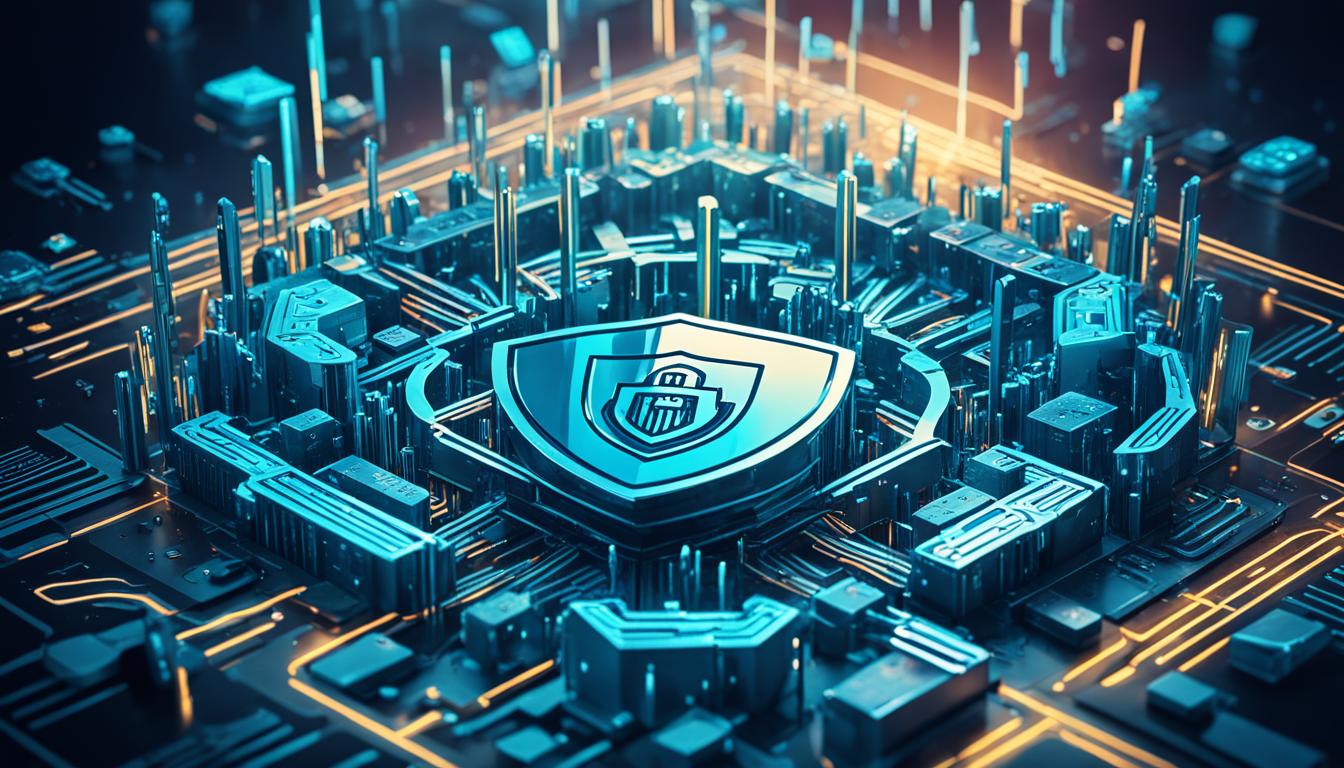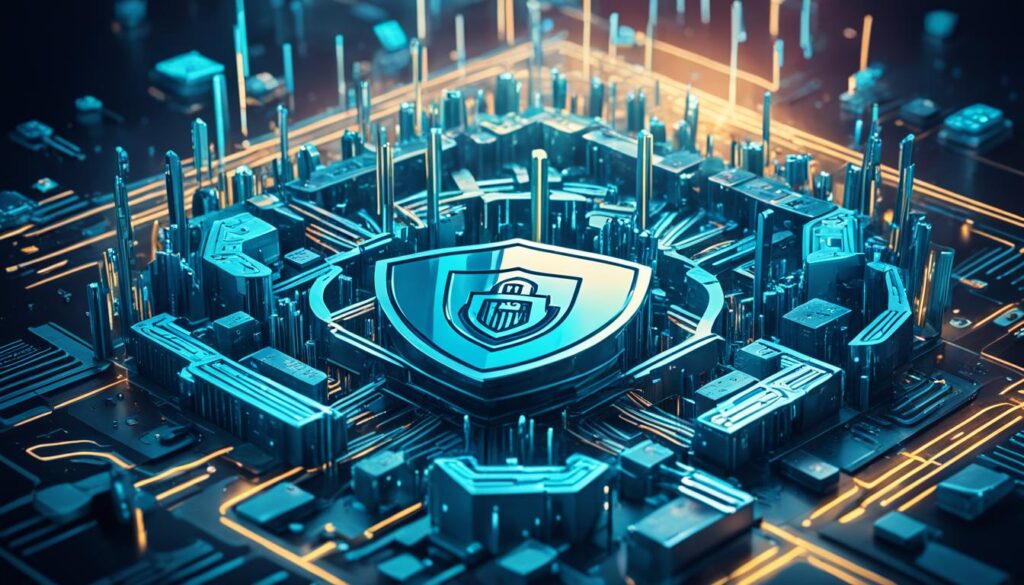How Cybersecurity Really Works: Protect Your Digital Living

How Cybersecurity Really Works: Protect Your Digital Life 2025
In today’s world, our lives are more digital than ever. Cybersecurity is key to keeping our personal and work lives safe. But have you thought about how it works and what you can do to protect yourself? Let’s explore the world of cybersecurity and find out how to stay safe online.
Do you feel your digital life is secure? Learn about the secrets of cybersecurity and how to keep up with changing threats. Take charge of your online safety and secure your digital future.
Key Takeaways
- Understand the fundamental principles of cybersecurity and how they protect your digital assets.
- Discover the latest cybersecurity threats and vulnerabilities that pose risks to your online activities.
- Explore the cutting-edge technologies and best practices that form the backbone of modern cybersecurity.
- Learn to navigate the complex landscape of cybersecurity regulations and compliance requirements.
- Develop a comprehensive strategy for managing cybersecurity risks and responding to incidents effectively.
Understanding the Fundamentals of Cybersecurity
In today’s world, cybersecurity is key. Our lives are more connected to technology, making it vital to protect our digital stuff and keep our online presence safe. Cybersecurity uses rules, methods, and plans to fight cyber threats. It keeps our information safe, whole, and easy to get to.
What is Cybersecurity?
Cybersecurity is about keeping systems, networks, and data safe from unauthorized access or harm. It’s a mix of tech, processes, and people working together. This helps fight threats like hacking, malware, and data breaches.
Read More: What is Cybersecurity? Types, Threats, and Cyber Safety Tips
The Importance of Cybersecurity in the Digital Age
Now, cybersecurity is a must for everyone – people, companies, and governments. With more devices online, cloud use, and smarter cyber attacks, it’s crucial. Good cybersecurity keeps data safe, protects important systems, and keeps users trusting the digital world.
Learning about cybersecurity helps us all get better at staying safe online. It prepares us for the new challenges we face in the digital world.
| Cybersecurity Principles | Cybersecurity Techniques |
|---|---|
|
|

Cybersecurity Threats and Vulnerabilities
In today’s digital world, it’s key to know the threats and weaknesses in our online spaces. Ark Solvers looks into the common cyber threats and attacks we face. They also share ways to spot and fix these weaknesses.
Common Cyber Threats and Attacks
Cybercriminals are always coming up with new ways to get into our networks and systems. Some top cyber threats are:
- Malware: This is harmful software that can harm or take over computer systems without permission.
Read More: What is Malware? Malware Definition, Types, and Protection
- Phishing: This is when scammers try to get sensitive info by sending fake emails or making fake websites.
Read More: What Is Phishing? – Definition, Types of Attacks, Examples
- Ransomware: This kind of malware locks up your files and demands money to unlock them.
Read More: What Is Ransomware? – Definition, Prevention & More
- Distributed Denial of Service (DDoS) attacks: These are when hackers flood a website or network with too much traffic to slow it down.
Read More: What is a Denial of Service (DoS) attacks? types, Examples
Identifying and Mitigating Vulnerabilities
Our systems and networks have weak spots that cyber threats can use to their advantage. Finding and fixing these weak spots is key to avoiding cyber-attacks. Here are some ways to do this:
- Regular checks and tests to find potential weak spots.
- Using strong network security tools like firewalls and systems to stop intruders.
- Keeping software and systems up to date to fix security issues.
- Training employees on cybersecurity will make them more careful.
- Creating and testing plans for when something goes wrong.
By staying on top of cyber threats and fixing weak spots, companies can better protect against cyber attacks. This makes their cybersecurity stronger overall.
Cybersecurity Best Practices and Strategies
In today’s world, keeping your digital life safe is key. At Ark Solvers, we offer a set of cybersecurity best practices and strategies. These help protect you from new threats.
Implementing Strong Cybersecurity Measures
It’s vital to have strong security steps in place. Here are some important steps to make your cybersecurity stronger:
- Use strict access controls and multi-factor authentication to check who you are and keep out unwanted visitors.
- Keep all software, operating systems, and apps up to date to fix security holes.
- Use top-notch threat detection and response to find and stop cyber-attacks quickly.
- Have and test detailed plans for when things go wrong to keep your business running smoothly.
- Teach your team about cybersecurity best practices, like spotting phishing scams and staying safe online.
| Cybersecurity Best Practices | Cybersecurity Defenses | Cybersecurity Frameworks | Threat Detection |
|---|---|---|---|
| Access controls, multi-factor authentication | Software updates, patch management | Incident response, disaster recovery | Advanced threat detection, employee training |
By using these strong cybersecurity steps, you can protect your digital stuff. This helps lessen the effects of cyber threats. It also makes your organization more resilient against new security challenges.
Read More: Exploring the Various Types of Cyber Security Threats
Cybersecurity Technologies and Solutions
In today’s digital world, cybersecurity technologies and solutions are key to keeping our networks and data safe. Tools like firewalls and encryption help protect our digital assets. These technologies are essential for modern cybersecurity.
Firewalls, Antivirus Software, and Other Security Tools
Firewalls guard against cyber threats by controlling network traffic. They help prevent unauthorized access. Antivirus software fights malware and viruses to keep devices safe.
Other tools, like intrusion detection systems and VPNs, boost network security. They work together to protect our data and networks.
Encryption and Data Protection Techniques
Encryption turns data into a code that only authorized people can read. Techniques like AES and RSA protect sensitive info. This way, even if data is intercepted, it can’t be read without the right keys.
Other methods, like access controls and secure storage, also protect data. They keep information safe, ensuring it’s not shared without permission.
The need for cybersecurity technologies and solutions is growing. These tools help us fight cyber threats and keep our online world safe. By using them, we can protect our digital assets and stay secure in a connected world.
How Cybersecurity Really Works
Cybersecurity is more than just using antivirus software or firewalls. It’s a detailed way to protect digital assets and data from threats. It uses complex mechanisms and protocols for a strong defense.
Encryption is a key part of cybersecurity. It turns information into a code only authorized people can open. This keeps sensitive data like personal info and business secrets safe.
Access control is also vital. It decides who can see or use certain resources. This includes strong passwords, biometric checks, and more to keep systems secure.
Security protocols watch for suspicious actions in networks or systems. Tools like intrusion detection and SIEM help spot and act on threats quickly.
Keeping software updated and using secure settings is also important. These steps help protect against new threats.
Knowing about cybersecurity helps people and companies make smart choices to keep their digital stuff safe. It’s about using the right strategies to fight cyber threats.
Read More: Different Types of Cyber Security: A Comprehensive Guide
Cybersecurity Risk Management and Incident Response
Dealing with cybersecurity means you need a strong plan that covers risk management and how to handle incidents. We’ll look at key steps to lower cyber risks and how to deal with security issues.
Assessing and Mitigating Cyber Risks
Risk management starts with checking your organization’s weak spots. This means doing vulnerability assessments often to find where hackers could get in. Knowing these spots lets you make plans to make your security better.
Having good security policies and training your team is key. Make sure your company has rules for keeping data safe, controlling access, and handling incidents. Teach your team about the latest ways to stay safe online to keep everyone alert and ready.
Responding to Cybersecurity Incidents
Even with the best efforts, cyber attacks can still happen. Having a clear cybersecurity incident response plan is vital. This plan should say what to do, who does what, and how to talk to others to lessen the blow to your online systems.
Quickly finding and acting on threats is crucial. Use strong monitoring and alerts to spot and stop threats quickly. Make incident response guides that help your team manage containment, removal, and recovery. This ensures a clear and organized way to lessen the harm.
Getting good at cybersecurity risk management and incident response helps protect your digital stuff and keeps your business running smoothly. Always be ready to change your plans to stay ahead of cyber threats.
Network Security and Data Protection Measures
In today’s digital world, keeping your network and data safe is key. At Ark Solvers, we know how important it is to use strong security and protection for your online stuff. We’ll look at the main ways to make your digital world safer.
Encryption Methods for Secure Data Transmission
Encryption is a big part of keeping your network safe. It makes your data unreadable if someone else gets their hands on it. We’ll talk about the latest ways to encrypt your data, like AES, SSL, and TLS.
Secure Coding Practices for Network Protection
Writing code safely is also crucial for network security. By doing things right in software development, you can lower the chance of hackers finding weaknesses. We’ll cover the main ideas of secure coding to help you make your network stronger.
| Network Security Measure | Description |
|---|---|
| Firewalls | Firewalls act as gatekeepers, monitoring and controlling the flow of traffic in and out of your network, helping to prevent unauthorized access and detect potential threats. |
| Virtual Private Networks (VPNs) | VPNs create a secure, encrypted tunnel for your internet traffic, allowing you to safely access your network and data from remote locations. |
| Intrusion Detection and Prevention Systems (IDS/IPS) | These systems monitor your network for suspicious activity and can automatically detect and respond to potential threats, helping to mitigate the impact of attacks. |
Using these security steps can help protect your online stuff and keep your network safe. Always be on the lookout and update your systems to fight off new cyber threats.
Ethical Hacking and Vulnerability Testing
In the fast-paced world of cybersecurity, ethical hackers are key to protecting digital systems. They use their skills to find weaknesses, test how strong digital systems are, and help companies improve their security.
The Role of Ethical Hackers in Cybersecurity
Ethical hackers, or “white hat” hackers, protect the digital world. They find security flaws through penetration testing and risk analysis. This helps them show companies how to beat cybersecurity risks before bad guys can.
Ethical hacking is about finding and checking for weaknesses in systems or networks. It includes detailed vulnerability testing to see how well security measures work. Ethical hackers also simulate cyber threats to see how well a company can handle them.
Thanks to their hard work, ethical hackers help companies stay ahead of cyber threats. By fixing weaknesses and using strong cybersecurity plans, companies can keep their digital stuff safe. They protect their customers’ private info and keep their stakeholders’ trust.
Cybersecurity Compliance and Regulations
In today’s fast-changing digital world, keeping up with cybersecurity laws is key for all businesses. Ark Solvers explores the complex rules and standards for protecting digital assets and data. By grasping these rules, companies can shield themselves from cyber threats and keep their operations safe.
Understanding Cybersecurity Laws and Standards
Rules like the General Data Protection Regulation (GDPR) and the Health Insurance Portability and Accountability Act (HIPAA) keep changing. Ark Solvers guides companies through these rules. They make sure strong cybersecurity policies and firewalls are set up to prevent cyber attacks. Also, using encryption and other data protection methods is vital for staying compliant and keeping sensitive info safe.
Ark Solvers keeps its clients updated on the newest cybersecurity laws and standards. This helps them stay secure, protect their digital assets, and show they care about responsible data handling. Being proactive with compliance builds trust with customers, partners, and regulators. It also helps companies stand out in the market.
FAQ
What is cybersecurity, and why is it important?
Cybersecurity is about protecting digital systems and data from unauthorized access or harm. It’s vital today because we rely more on technology and the internet. This makes us open to cyber threats and attacks. Good cybersecurity keeps our personal info, money, and important systems safe from cybercriminals and hackers.
What are the common types of cyber threats and attacks?
Common cyber threats include malware, phishing, ransomware, DDoS attacks, and data breaches. Hackers use these to get into systems, steal data, disrupt services, or demand ransom. Knowing about these threats helps us fight back with better cybersecurity.
How can I identify and mitigate vulnerabilities in my digital systems?
Finding and fixing vulnerabilities is key in cybersecurity. This means doing regular checks to spot weaknesses that hackers could use. Once you find them, you can fix them by updating software, using security patches, and improving access controls.
What are some best practices for implementing strong cybersecurity measures?
To boost your cybersecurity, use strong passwords, enable two-factor authentication, and keep software updated. Back up your data often and train your employees on cybersecurity. Using a framework like the NIST Cybersecurity Framework can also help you plan a strong security strategy.
What are some key cybersecurity technologies and solutions?
Good cybersecurity uses tools like firewalls, antivirus software, encryption, VPNs, and SIEM systems. These help detect and stop cyber threats, protecting your digital assets and keeping your systems and data safe.
How do ethical hacking and vulnerability testing help with cybersecurity?
Ethical hackers, or “white hat” hackers, are key in cybersecurity. They test digital systems to find and fix weaknesses. By mimicking real cyber attacks, they help companies see their security level, test defenses, and make needed changes to stay safe.


